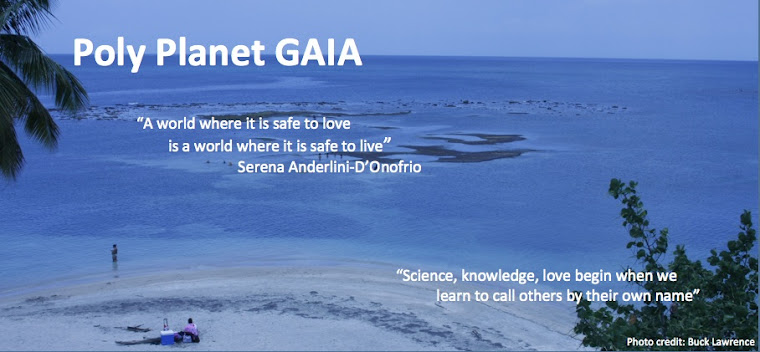Bisexual Epistemologies: A Journey from Nausea to Commitment
An occasional piece by
Serena Anderlini-D’Onofrio, PhD
For The Journal of Bisexuality’s 10th Anniversary Issue
Hi dear readers!
This seven-in-one piece will be great fun--yours truly promises. Find out all the ins and outs of 10 years of Bisexuality! What does "epistemology"mean? Big word, right? Well, all it means is that when you're making love you're producing knowledge. A good thing!
We follow the abstract with the Introduction, and will have five more posts. Really revealing of all those things about bi you've always been curious about. Why is it so good? What can it do for you? For the planet? For the future? For authentic intimacy? It's all here, spiced with a bit of irony and critique of why we're so behind on our agenda. What's keeping us from being more efficient.
Also arcane words you've been told have no meaning unless you got a PhD are explained--made very easy! "Nausea," "existentialism": it's all about the chakra system--really. Commitment? It's not about going to jail (as in, "being committed"). But rather, it's about "being-in-action" about things. Being the one who makes the difference! No mysteries. Woooooow! Come back for more, will you? We'll post every week, on Tuesdays.
Namaste,
Serena





2. Introduction
It is an acknowledgement to be invited to contribute to this anniversary issue.[1] Ten Years of Bisexuality is how fellow-traveler eclectic and queer-theory pioneer David Halperin would probably call this--not to mention Nobel Laureate in Literature Gabriel Garcia Marquez, who might have preferred Ten Years of Solitude.[2] Let this occasional piece be an opportunity to analyze the miracle of planetary consciousness and political circumstances that has been at cause of my being part of it, and reflect on what we might learn from the results.
In 2003 I was invited to guest edit the issue that became Women and Bisexuality: A Global Perspective. Regina Reinhardt, the journal’s associate editor, was a close collaborator of Fritz Klein, founder of the journal. She offered the opportunity and the issue ended up collecting articles from four different continents. In 2005 I invited myself to guest-edit an issue on the intersections of polyamory and bisexuality. Fritz Klein initially resisted the idea. As a seasoned good listener who would allow eloquence and a good argument to convince him, he eventually agreed. It became Plural Loves: Designs for Bi and Poly Living, now an appreciated book in poly communities for research and practice. Fritz Klein passed in 2006, and I remember writing, in a post-traumatic state of semi-trance from the death of a respected friend and intimate leader, “In Absentia,” a short introductory piece for the issue about to go to print. When Jonathan Alexander came in as editor-in-chief anointed by the Fritz Klein legacy that funds this initiative, I proposed Bisexuality and Queer Theory (2010).[3] This issue is now in production as a book that promises to bridge the discursive gap between practice and theory, communities and ivy leagues, or the body and the mind, to use shorthand from new age speak. There were no conferences in North America in years subsequent to Klein’s passing that would offer spaces for continuance of the integration of discourses auspicated by the activist scholarship to which I devote my energies. When the energies for one such conference jelled in England, in 2010, I was invited to keynote and sparkled the idea of the proceedings volume that became BiTopia, now in print as a journal issue.[4]
Every issue has been a labor of love devoted to the overarching commitment to the scientific invention of a world where love for love, or erotophilia, is revered. As an activist scholar, I don’t follow trends that promise prestige. I chart new fields that offer the opportunity to make the world a better place for those who love love as I do and are willing to stand for an inclusive amorous vision beyond binaries and divisive dualisms. This requires a public profile that involves risk. It also involves the effort of being beyond the lateral hostilities that often make coordination among activists, communities, advocates, and academics difficult, as well as a vision whose horizon is wider than the sum of often conflicting academic sectors and disciplines. I hope to have kept faith to my overarching intent at all times, even though I am aware that in some cases this is just wishful thinking.
Over this period I have considered myself a participant observer and research activist of bisexuality, as an in-flux identity, a diverse community, a subculture interspersed with tropes from other, contiguous groups, and a practice of love rich with many variations. Bisexuality is just as healthy as any other sexual orientation, Fritz Klein established with his seminal work in the mid 1980s, The Bisexual Option. If fact, when social and cultural causes for neuroses that can accrue from it are removed, it is even healthier since it corresponds to the potential for “100 Percent Intimacy,” as indicated in the subtitle he chose for that book.[5] Klein focused on how this applies to the individual, as in the kind of therapeutic approach that can help a bisexual person feel comfortable with her/his orientation and related practices of love.
Today cultural discourse about the interconnection between sexuality and consciousness has developed much further. Many of us believe that active sexual education and amorous expression, not the stillness of a couch with the “talking cure,” is where the healing begins. We are also more aware of planetary consciousness, or the noosphere--which has been further activated by cyberspace interactivity. In this evolving cultural context, Klein’s claim about the health of a bisexual person can be projected on the wider horizon of global ecological health, which can thrive on the expansion of human sexual fluidity and amorous inclusiveness. In a homeopathic rhetorical turn, one might theorize bisexuality, and/or the fear thereof, as the “problem” which is the solution, the “disease” which is the cure, the “lie” which is the truth, in an algorithm with the potential to heal personal, relational, cultural, social, ecological, emotional, and economic wounds all the way back to Plato’s dualisms.
When we look forwards we can envision bisexuality as an engine in the paradigmatic shift toward a future of sexual fluidity and amorous inclusiveness where the energies of love and life are revered. In other words, bisexuality is the foundation of a new epistemology based on love for our hostess, third planet Gaia, and the mantle teeming with life that she has enshrined herself in to welcome the life journeys of an amazing range of interdependent beings, from humans to bacteria and everything in between.[6]
If bisexuality is an epistemology--or at least a significant element in the new episteme toward which planetary consciousness is shifting--then we may want to go back to literature, the art of wordsmiths, to sort out what this means.
[1] Jonathan Alexander, the editor-in-chief whose rhetorical expertise has been so instrumental in keeping the Journal going since Fritz Klein’s death, is the one who helped me see the call to contribute to this issue as a form of recognition for my role in affirming the Klein legacy. I owe him many of the insights of this piece. Our conversations were very inspiring. Another debt is owed Regina Reinhardt for also insisting. Thank you!
[2] My references are David Halperin, One Hundred Years of Homosexuality, and its palimpsest, Gabriel Garcia Marquez, One Hundred Years of Solitude, by now two respected classics in their own discursive ambits.
[3] Articles and Introduction available here: http://www.tandf.co.uk/journals/spissue/wjbi-si.asp, book review section available here: http://polyplanet.blogspot.com/search/label/Bisexuality%20-%20We%20Are%20Everywhere
[4] Introduction pre-published on Poly Planet Gaia, here: http://polyplanet.blogspot.com/search/label/BiTopia%3A%20Intro%20to%20BiReCon%20Proceedings%20Volume. My contribution to this issue, from my keynote, is also available on Poly Planet Gaia, here:
[5] The Bisexual Option was published in the early 1980s with the subtitle A Concept of One Hundred Percent Intimacy. It went into its second edition in 1993.
[6] The reference here is my own work on bisexuality and global ecological theory, in Gaia and the New Politics of Love (2009).
Yours truly appreciates your attention. Stay tuned for more wonders.
Namaste,
Serena Anderlini-D'Onofrio, PhD
Namaste,
Serena Anderlini-D'Onofrio, PhD
Gilf Gaia Extraordinaire
Author of Gaia and the New Politics of Love and many other books
Professor of Humanities
University of Puerto Rico, MayaguezProfessor of Humanities
Follow us in the social media
Poly Planet GAIA Blog: http://polyplanet.blogspot.
Website: www.serenagaia.com
Become a Fan: www.facebook.com/GaiaBlessings
Author's Page/Lists all books: http://www.amazon.com/-/e/
YouTube Uploaded Videos: http://www.youtube.com/





















